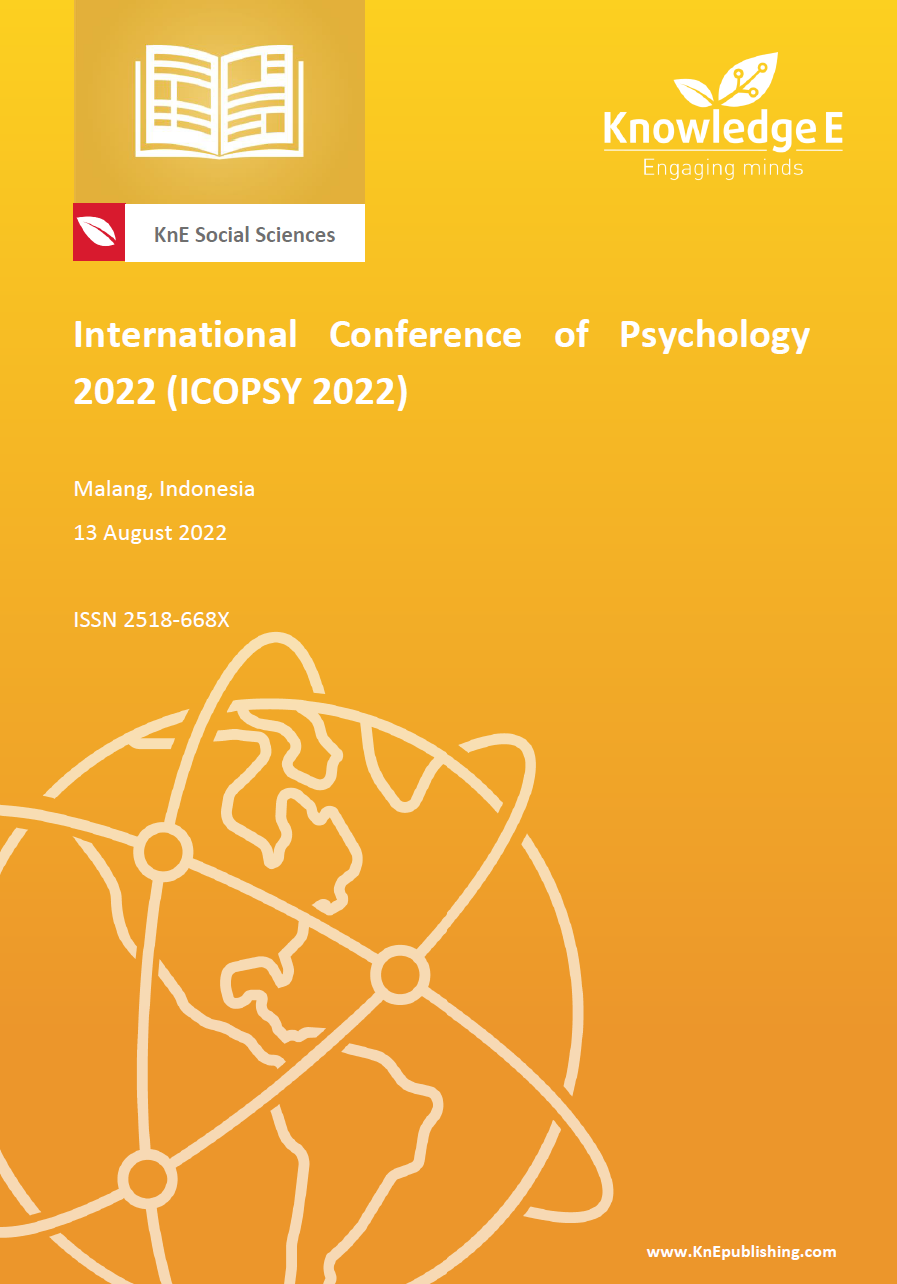The Relationship between Workplace Well-being and Burnout Among Healthcare Professionals in Medika Utama Clinic Sidoarjo during the COVID-19 Pandemic
DOI:
https://doi.org/10.18502/kss.v7i18.12379Abstract
This research aimed to identify the relationship between workplace well-being and burnout among the healthcare professionals in Medika Utama Clinic Sidoarjo during the COVID-19 pandemic. This research was conducted by implementing a quantitative approach and correlational research design. Purposive sampling was conducted and 34 subjects were selected. The instrument used in this research was the adaptation scale, and the first scale was the Multidimensional Workplace Well-being Questionnaire obtained from Black Dog Institute, while the validity value on this scale is in the range of .536 - .810. The second scale, namely Maslach Burnout Inventory (MBI), has a validity value on this scale with a range of .441 – .792 and a reliability of .922 by using the Likert scale. The hypothesis test revealed that there was a relationship between workplace well-being and burnout (.020). Moreover, the Multidimensional Workplace Well-being Questionnaire result indicated that there is no relationship between job satisfaction and burnout (.126), the organization’s respect (towards employees) and burnout (.059), the company’s concern (to employees) and burnout. (.137), but there is a relationship between work interference (with employees’ personal lives) and burnout (.003). In order to avoid burnout, the organization must concern with the work interferences which influence the personal lives of the employees.
Keywords: workplace well-being, burnout, healthcare professionals
References
Kominfo. COVID-19 Situation in Indonesia update 9 November 2021. 2021, November 9. https://covid19.go.id/article/2021/11/09/data-vaccination-covid-19- update-9-november-2021
Juan VAN, Aceituno D, Djellouli N, et al. Mental health and well-being of healthcare workers during the COVID-19 pandemic in the UK: contrasting guidelines with experiences in practice. BJPsych Open. 2020;7(1):e15. https://doi.org/10.1192/bjo.2020.148
Suryani A, Setiowati R, Suharsono JT, Handrija H. Penggunaan alat pelindung diri (APD) terhadap keselamatan kerja perawat pada era pandemi COVID-19 di ruang isolasi RS Kanker Dharmais. The Journal of Hospital Accreditation. 2022;4(1):36–39. https://doi.org/10.35727/jha.v4i1.107
Yıldırım M, Arslan G, Özaslan A. Perceived risk and mental health problems among healthcare professionals during COVID-19 pandemic: Exploring the mediating effects of resilience and Coronavirus fear. International Journal of Mental Health and Addiction. 2020;20(2):1035–1045. https://doi.org/10.1007/s11469-020-00424-8
Matela D. Personal protective equipment should fit the workplace. 2010. Accessed from https://www.safetyandhealthmagazine.com/articles/personal-protectiveequipment- should-fit-the-workplace-2
Lai J, Ma S, Wang Y, et al. Factors associated with mental health outcomes among health care workers exposed to Coronavirus disease 2019. JAMA Network Open. 2020;3(3):e203976. https://doi.org/10.1001/jamanetworkopen.2020.3976.
Abdelghani M, El-Gohary HM, Fouad E, Hassan MS. Addressing the relationship between perceived fear of COVID-19 virus infection and emergence of burnout symptoms in a sample of Egyptian physicians during COVID-19 pandemic: a crosssectional study. Middle East Current Psychiatry, Ain Shams University. 2020;27(1):70. https://doi.org/10.1186/s43045-020-00079-0
Elhadi M, Msherghi A, Elgzairi M, et al. Burnout syndrome among hospital healthcare workers during the COVID-19 pandemic and civil war: A cross-sectional study. Frontiers in Psychiatry. 2020;11:579563. https://doi.org/10.3389/fpsyt.2020.579563
Corrêa JS, Lopes LFD, Almeida DM, Camargo ME. Workplace wellbeing and burnout syndrome: Opposite faces in penitentiary work. Revista de Administração Mackenzie. 2019;20(3).1-30. https://doi.org/10.1590/1678-6971/eRAMG190149
Tawale EN, Budi W, Nurcholis G. Relationship between Work motivation of nurses and nurse’s burnout tendency in RSUD Serui-Papua. Media INSAN Media Psikologi. 2011;13(02):11.
Maslach C, Leiter MP. Early predictors of job burnout and engagement. Journal of Applied Psychology. 2008;93(3):498–512. https://doi.org/10.1037/0021- 9010.93.3.498
Kun Á, Balogh P, Krasz KG. Development of the work-related well-being questionnaire based on Seligman’s PERMA model. Periodica Polytechnica Social and Management Sciences. 2016;25(1):56–63. https://doi.org/10.3311/PPso.9326
Black Dog Institute. Workplace wellbeing questionnaire: Black Dog Institute. 2014.
Beaton DE, Bombardier C, Guillemin F, Ferraz MB. Guidelines for the process of cross-cultural adaptation of self-report measures. Spine. 2000;25(24):3186–3191. https://doi.org/10.1097/00007632-200012150-00014
Sugiyono S. Metode penelitian pendidikan (Pendekatan kuantitatif, kualitatif, dan R&D). Bandung: Alfabeta; 2015.
Sugianto KMS, Hariyati RTS, Galleryzki AR. Pola shift perawat di masa pandemi COVID-19. Journal of Telenursing (JOTING). 2021;3(1):136–144. https://doi.org/10.31539/joting.v3i1.2157
Ariati J. Subjective well-being (Kesejahteraan Subjektif) dan kepuasan kerja pada staf pengajar (Dosen) di lingkungan fakultas Psikologi Universitas Diponegoro. Jurnal Psikologi. 2017;8(2):117–123. https://doi.org/10.14710/jpu.8.2.117-123
Dixon E, Murphy M, Wynne R. A multidisciplinary, cross-sectional survey of burnout and wellbeing in emergency department staff during COVID-19. Australasian Emergency Care. 2022;25(3):247–252. https://doi.org/10.1016/j.auec.2021.12.001
Duarte I, Teixeira A, Castro L, Marina S, Ribeiro C, Jácome C, Martins V, Ribeiro-Vaz I, Pinheiro HC, Silva AR, Ricou M, Sousa B, Alves C, Oliveira A, Silva P, Nunes R, Serrão C. Burnout among Portuguese healthcare workers during the COVID-19 pandemic. BMC Public Health. 2020;20(1):1885. https://doi.org/10.1186/s12889-020-09980-z
Suryanto S. Kepuasan kerja dan persepsi perawat tentang kepemimpinan dengan kinerja perawat pasca sertifikasi ISO 9001/2008. Jurnal Manajemen Pelayanan Kesehatan. 2011;14(1):36–43.
Wirawan B. Analisis hubungan antara kepuasan kerja dan kinerja karyawan dengan Structural Equation Modeling (SEM): Studi kasus di PT Yamaha Music MFG Asia. Proceedings. 2017;1(1):270–279.
Laschinger HK, Finegan J. Using empowerment to build trust and respect in the workplace: a strategy for addressing the nursing shortage. Nursing Economic. 2005;23(1):6–3.
Sunarta S. Pentingnya kepuasan kerja. Efisiensi-Kajian Ilmu Administrasi. 2019;16(2):63–75. https://doi.org/10.21831/efficiency.v16i2.27421v

